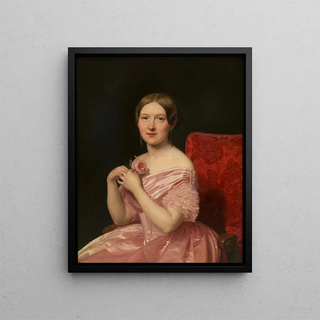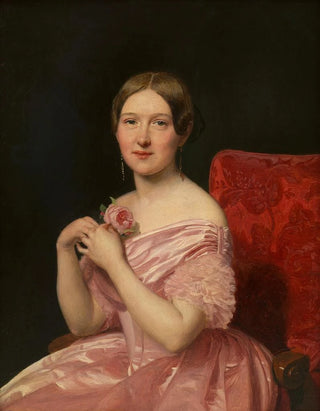Art print | Young woman in pink satin dress - Ferdinand Georg Waldmüller Source: Reproduction | Jeune femme en robe de satin rose - Ferdinand Georg Waldmüller


View from behind

Frame (optional)
In the rich and captivating world of 19th-century art, the "Young woman in pink satin dress" by Ferdinand Georg Waldmüller stands out for its delicacy and expressiveness. This painting, which captures the timeless beauty of a young woman dressed in a soft, luminous satin dress, invites the viewer to immerse themselves in a moment of grace and serenity. Waldmüller, with his unparalleled talent for depicting light and texture, manages to transcend mere representation to offer a true emotional experience. Through this work, the artist transports us to a world where beauty and elegance blend with subtle introspection.
Style and uniqueness of the work
Waldmüller's style is characterized by striking realism, combined with a romantic sensitivity that permeates each of his creations. In "Young woman in pink satin dress," the mastery of colors and nuances is particularly remarkable. The satin dress, with its radiant softness, almost seems to vibrate under the light, while the young woman's face exudes an expression that is both gentle and contemplative. The meticulous details, from the folds of the fabric to the reflections of light on her skin, demonstrate a remarkable attention to technique. This work is not limited to a simple depiction of a female figure; it evokes a dreamlike atmosphere, where each element contributes to creating visual and emotional harmony. The blurred backgrounds, often characteristic of Waldmüller's work, help focus attention on the main subject, thus enhancing the scene's intimacy.
The artist and his influence
Ferdinand Georg Waldmüller, born in 1793 in Austria, is often regarded as one of the pioneers of realism in painting. His career, marked by a constant exploration of everyday life themes and portraits, has had a lasting impact on the development of art in the 19th century. Waldmüller was able to capture the essence of his subjects with a precision unique to him, while incorporating elements of the romantic life of his era. His influence is felt not only in his own

Matte finish

View from behind

Frame (optional)
In the rich and captivating world of 19th-century art, the "Young woman in pink satin dress" by Ferdinand Georg Waldmüller stands out for its delicacy and expressiveness. This painting, which captures the timeless beauty of a young woman dressed in a soft, luminous satin dress, invites the viewer to immerse themselves in a moment of grace and serenity. Waldmüller, with his unparalleled talent for depicting light and texture, manages to transcend mere representation to offer a true emotional experience. Through this work, the artist transports us to a world where beauty and elegance blend with subtle introspection.
Style and uniqueness of the work
Waldmüller's style is characterized by striking realism, combined with a romantic sensitivity that permeates each of his creations. In "Young woman in pink satin dress," the mastery of colors and nuances is particularly remarkable. The satin dress, with its radiant softness, almost seems to vibrate under the light, while the young woman's face exudes an expression that is both gentle and contemplative. The meticulous details, from the folds of the fabric to the reflections of light on her skin, demonstrate a remarkable attention to technique. This work is not limited to a simple depiction of a female figure; it evokes a dreamlike atmosphere, where each element contributes to creating visual and emotional harmony. The blurred backgrounds, often characteristic of Waldmüller's work, help focus attention on the main subject, thus enhancing the scene's intimacy.
The artist and his influence
Ferdinand Georg Waldmüller, born in 1793 in Austria, is often regarded as one of the pioneers of realism in painting. His career, marked by a constant exploration of everyday life themes and portraits, has had a lasting impact on the development of art in the 19th century. Waldmüller was able to capture the essence of his subjects with a precision unique to him, while incorporating elements of the romantic life of his era. His influence is felt not only in his own






